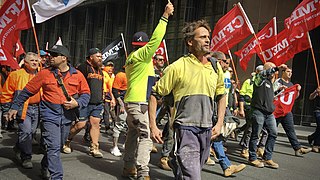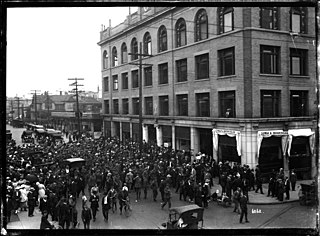Related Research Articles
A trade union or labor union, often simply referred to as a union, is an organisation of workers intent on "maintaining or improving the conditions of their employment", such as attaining better wages and benefits, improving working conditions, improving safety standards, establishing complaint procedures, developing rules governing status of employees and protecting and increasing the bargaining power of workers.

The National Labor Relations Act of 1935, also known as the Wagner Act, is a foundational statute of United States labor law that guarantees the right of private sector employees to organize into trade unions, engage in collective bargaining, and take collective action such as strikes. Central to the act was a ban on company unions. The act was written by Senator Robert F. Wagner, passed by the 74th United States Congress, and signed into law by President Franklin D. Roosevelt.

Strike action, also called labor strike, labour strike, or simply strike, is a work stoppage caused by the mass refusal of employees to work. A strike usually takes place in response to employee grievances. Strikes became common during the Industrial Revolution, when mass labor became important in factories and mines. As striking became a more common practice, governments were often pushed to act. When government intervention occurred, it was rarely neutral or amicable. Early strikes were often deemed unlawful conspiracies or anti-competitive cartel action and many were subject to massive legal repression by state police, federal military power, and federal courts. Many Western nations legalized striking under certain conditions in the late 19th and early 20th centuries.
Collective bargaining is a process of negotiation between employers and a group of employees aimed at agreements to regulate working salaries, working conditions, benefits, and other aspects of workers' compensation and rights for workers. The interests of the employees are commonly presented by representatives of a trade union to which the employees belong. A collective agreement reached by these negotiations functions as a labour contract between an employer and one or more unions, and typically establishes terms regarding wage scales, working hours, training, health and safety, overtime, grievance mechanisms, and rights to participate in workplace or company affairs. Such agreements can also include 'productivity bargaining' in which workers agree to changes to working practices in return for higher pay or greater job security.

Transport Workers Union of America (TWU) is a United States labor union that was founded in 1934 by subway workers in New York City, then expanded to represent transit employees in other cities, primarily in the eastern U.S. This article discusses the parent union and its largest local, Local 100, which represents the transport workers of New York City. TWU is a member of the AFL–CIO.
Mexican labor law governs the process by which workers in Mexico may organize labor unions, engage in collective bargaining, and strike. Current labor law reflects the historic interrelation between the state and the Confederation of Mexican Workers, the labor confederation officially aligned with the Institutional Revolutionary Party, which ruled Mexico under various names for more than seventy years.

A strikebreaker is a person who works despite a strike. Strikebreakers are usually individuals who were not employed by the company before the trade union dispute but hired after or during the strike to keep the organization running. Strikebreakers may also refer to workers who cross picket lines to work.
Labour unions emerged in Japan in the second half of the Meiji period, after 1890, as the country underwent a period of rapid industrialization. Until 1945, however, the labour movement remained weak, impeded by a lack of legal rights, anti-union legislation, management-organized factory councils, and political divisions between “cooperative” and radical unionists.

Labor unions represent United States workers in many industries recognized under US labor law since the 1935 enactment of the National Labor Relations Act. Their activity today centers on collective bargaining over wages, benefits, and working conditions for their membership, and on representing their members in disputes with management over violations of contract provisions. Larger trade unions also typically engage in lobbying activities and electioneering at the state and federal level.

Union busting is a range of activities undertaken to disrupt or prevent the formation of trade unions or their attempts to grow their membership in a workplace.
Graduate student employee unionization, or academic student employee unionization, refers to labor unions that represent students who are employed by their college or university to teach classes, conduct research and perform clerical duties. As of 2014, there are at least 33 US graduate employee unions, 18 unrecognized unions in the United States, and 23 graduate employee unions in Canada. By 2019, it is estimated that there were 83,050 unionized student employees in certified bargaining units in the United States. Prior to the 2,000s almost all US graduate employee unions are located in public universities, most of which formed during the 1990s. However, that is no longer true today with many private universities now being organized. In 2014, New York University's Graduate Student Organizing Committee, affiliated with the United Automobile Workers (UAW), became the first graduate employee union recognized by a private university in the US. In September 2018, Brandeis University became the second private university to negotiate a collective bargaining agreement for graduate student employees, followed by Tufts University in October 2018 and Harvard in July 2020. American University and New School were in the process of negotiating an agreement as of September 2018. Many of these unions refer to their workers as Academic Student Employees (ASEs) to reflect the fact that their membership may also include undergraduate students working in represented job classifications. In 2019, the National Labor Relations Board (NLRB) proposed a new rule that said graduate students are not employees, which could affect unionization efforts at private universities, although the final rule has yet to be published.
Trade unions in Ghana first emerged in the 1920s and played an important role in the country's economy and politics ever since.

Labor relations is a field of study that can have different meanings depending on the context in which it is used. In an international context, it is a subfield of labor history that studies the human relations with regard to work in its broadest sense and how this connects to questions of social inequality. It explicitly encompasses unregulated, historical, and non-Western forms of labor. Here, labor relations define "for or with whom one works and under what rules. These rules determine the type of work, type and amount of remuneration, working hours, degrees of physical and psychological strain, as well as the degree of freedom and autonomy associated with the work." More specifically in a North American and strictly modern context, labor relations is the study and practice of managing unionized employment situations. In academia, labor relations is frequently a sub-area within industrial relations, though scholars from many disciplines including economics, sociology, history, law, and political science also study labor unions and labor movements. In practice, labor relations is frequently a subarea within human resource management. Courses in labor relations typically cover labor history, labor law, union organizing, bargaining, contract administration, and important contemporary topics.

The American Federation of State, County and Municipal Employees (AFSCME) is the largest trade union of public employees in the United States. It represents 1.3 million public sector employees and retirees, including health care workers, corrections officers, sanitation workers, police officers, firefighters, and childcare providers. Founded in Madison, Wisconsin, in 1932, AFSCME is part of the AFL–CIO, one of the two main labor federations in the United States. AFSCME has had four presidents since its founding.

The Trade Union Law is a Japanese law. It was enacted on 1 June 1949 to provide the right for workers to organize in Japan. It has been translated as the "Trade Union Law" and "Labor Union Law".
Edgar Fitzgerald Gordon, born in Trinidad and Tobago, was a physician, parliamentarian, civil-rights activist and labour leader in Bermuda, and is regarded as the "father of trade unionism" there: "he championed the cause of Bermudian workers and fought for equal rights for black Bermudians, thereby laying the groundwork for much of the political and social change that came about after his death". He was president of the Bermuda Industrial Union (BIU) 1945–55. Gordon has been described as "perhaps the only black charismatic leader to have emerged in the island's modern political history", and as "Bermuda's most dedicated Pan-Africanist".

Barbara BallMRCS, LRCP, OBE was a Bermudian physician, politician and social activist. She was the first woman physician to practice in Bermuda and took both black and white patients, an unusual event in the 1950s. During the time that segregation was rigidly enforced, Ball actively ignored the social norms, actively fighting for the civil rights of black Bermudians. She served as a member of the Parliament of Bermuda and represented black workers through her work with the Bermuda Industrial Union. In 1963, at a United Nations meeting regarding colonialism, Ball brought the situation of black workers on the island to the table. In 2000, she was honoured as an officer of the Order of the British Empire.
Eva Naomi Hodgson was a Bermudian activist, writer, union leader, and educator. She was known for her efforts to fight racism in Bermuda, from the segregation era into the 21st century.
This article discusses the history and present status of labor unions in Sudan.
IBM worker organizations have not historically been recognized by IBM. Since the company's foundation in 1911, it has not recognized any trade unions in the United States, despite the efforts by workers to establish them from 1970 onward. In Germany and Australia there are several trade unions recognized by IBM, with limited recognition.
References
Citations
- ↑ Alexander & Parker 2004, p. 101.
- ↑ Ebbin 2011.
- 1 2 3 Alexander & Parker 2004, p. 104.
- 1 2 3 Alexander & Parker 2004, p. 102.
- 1 2 Bernews 2011.
- ↑ Alexander & Parker 2004, p. 103.
Bibliography
- ICTUR; et al., eds. (2005). Trade Unions of the World (6th ed.). London, UK: John Harper Publishing. ISBN 0-9543811-5-7.
- Alexander, Robert J.; Parker, Eldon M. (2004). A History of Organized Labor in the English-speaking West Indies. Westport, Connecticut: Greenwood Publishing Group. ISBN 978-0-275-97743-6.
- Ebbin, Meredith (15 June 2011). "Woman of Conscience". Hamilton, Bermuda: The Bermudian. Archived from the original on 14 November 2017. Retrieved 14 November 2017.
- "The Loss of Dr Barbara Ball". Bernews . Hamilton, Bermuda. 14 March 2011. Archived from the original on 23 March 2017. Retrieved 15 November 2017.
